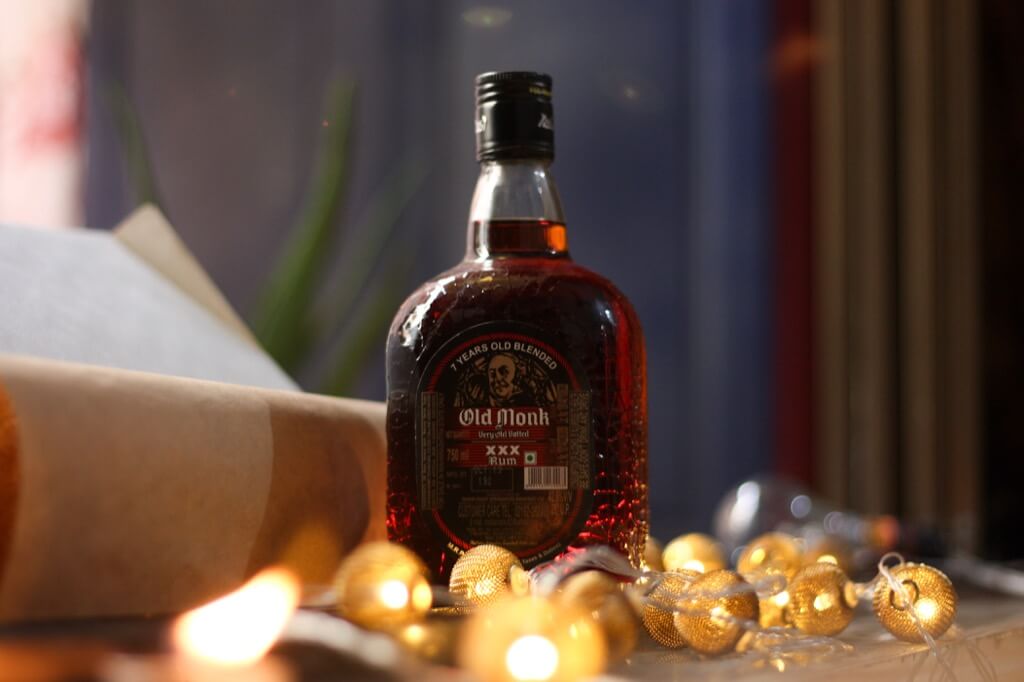Rum is created by fermenting either sugarcane juice or molasses, a waste product of sugar manufacturing. The next step is distillation using column or pot stills. The finished product can be aged in oak barrels or bottled unaged as white rum.
This aging process is responsible for the color as well as the flavor. Oak aging produces rich, flavorful dark rum with hints of wood, leather, cocoa, vanilla, spices, tannins, coffee, and chocolate. Truly, that is astounding. The Caribbean sun plays an additional role in the aging process of rum; the warm weather speeds up the process, making it mature at a rate up to three times that of Scotch whisky.
Another interesting thing is that when spirits are aged in oak barrels that were once used to age sherry or bourbon, the spirit takes on the flavors of the wood. For example, bourbon gets toasty vanilla and smoke, while sherry gets raisin-like, sweet, Christmassy flavors.
However, it’s not so easy because caramel is the coloring agent used to give many rums their color. To further complicate matters, the color of a dark rum can be imparted by either aging or artificial coloring. The world of rum is full of twists and turns. From mild, creamy, and pleasantly sour to complex, peppery, and incredibly stinky, dark rums cover the spectrum.
A Guide to Properly Enjoying Dark Rum
Exceptional cocktails can be made with the finest dark rums, or they can be savored neat, and taken at a leisurely pace. In the end, it doesn’t matter if you pour yourself a glass of booze or not; the important thing is that you enjoy it.
Having said that, classic cocktails are the best way to taste dark rum. Some excellent examples are Dark and Stormy and Planter’s Punch. Also, a Painkiller is a great cocktail to whip up if you happen to have some Pusser’s rum on hand.
Use any vessel you choose when sipping rum neat. The way a glass looks and feels can often enhance the drinking experience. You can’t go wrong with a tulip-shaped tasting glass, though, if you’re after the most aromatic and flavorful rum possible.
Artisanal Dark Rum
Rum is a spirit that has no borders and may be produced anywhere in the globe; nonetheless, the Caribbean and Latin America are home to some of the best rums in the world. Rum originated here, and the various types seen there reflect the many African slaves brought to the area by the many empires who farmed sugarcane there centuries ago. Rum does have a shadowy side. For a more in-depth explanation of rum classification, check out this resource. It’s not perfect. Because some individuals still use these old methods of ordering and classifying rum, we’ll go over them here.
“British” Rum Flavor
Similar to their Spanish equivalents, British-style rums are distilled from molasses, a byproduct of sugar processing; this type has a long history and tradition associated with the Royal Navy. Nevertheless, they are often distilled in pot stills rather than column stills and undergo a lengthier fermentation process. The style is often linked with a lengthier maturing period, which yields rum that is exceptionally thick, oily, and spicy. Barbados, Jamaica, Trinidad & Tobago, and Guyana are prime examples of what we’re talking about.
Another feature of this style, especially in Jamaica, is a distinctive flavor called “funk” that is created by chemical compounds called esters. Funk has a little, um, funky flavor. Unusual as it may sound, once you taste the overripe tropical fruits, tar, savory undertones, and umami, you won’t be able to get enough. It used to be that huge brands of high-impact rum were blended with lighter kinds to give them more flavor and body. However, these days it’s more common to find single-estate rums, where you can taste the product unfiltered.
The Royal Navy has a long association with British rum, hence it is common practice to bottle navy strength (100-proof imperial, or little more than 57% ABV) for this brand. A cocktail made with one of these potent spirits is sure to be a hit thanks to the peppery intensity that cuts through the other ingredients.
“Spanish” Rum
The Spanish-speaking countries of the Caribbean and Latin America produce rum, which is characterized by a lighter and sweeter style. Rum is typically made from molasses, with a small amount of sugar cane honey (concentrated sugar juice) added for flavor. It is distilled using continuous column stills, though alternative methods are also employed (see above), and is exported by countries such as Cuba, Panama, and Puerto Rico. The rum’s milder character is mostly due to these stills.
The process of aging is another important factor. Rum aged in a racked arrangement of casks is known as the solera system in several Spanish-speaking nations. It all starts with adding new, unaged spirit to the top barrels and working its way down as it ages. In a continual cycle, finished rum is drawn from the bottom barrels, and new spirit is poured into the top barrels. This process, which has long been associated with making sherry and Brandy de Jerez, yields a spirit that is exceptionally well-balanced and consistent.
French Rum, Often Known as Rhum Agricole
One of the most lucrative commodities for the French empire during its height was sugar, which the Caribbean possessions produced in vast quantities. The value of sugarcane, however, fell precipitously as a result of upheaval in the French Caribbean, increased sugar beet output in Europe, and war with Britain. Rum became a far more lucrative business as a result, and many distillers abandoned molasses in favor of sugarcane juice and fermentation.
The French-speaking areas of Martinique, Guadeloupe, and French Guiana, as well as the Portuguese island of Madeira, produce the most prevalent form of sugar cane rum, known as rhum agricole. The term “vieux” refers to a wine that has been aged for longer than three years in oak barrels, whereas “ambré” describes a young-aged wine. Unaged rum, sometimes called blanc (white) rum, is another option, as are various varieties of rum. The savory, herbal flavors of this style make it perfect for both sipping on its own and adding to drinks. Although it differs greatly from traditional rums made in Spain and the United Kingdom, this one-of-a-kind spirit is sure to be a crowd-pleaser. Rhum Agricole must adhere to certain regulations to be classified as such; hence, some rums that have these characteristics, such as Haitian clairin or Brazilian cachaça, are not considered rhum agricole.
Our Top Picks For Dark Rums
Pussers Gunpowder Proof Black Label
- Strength: Navy Strength, 57% ABV
- Origin: Guyana, typical of British rums
- Flavor: Intense, spicy, and sweet
- Use: Ideal for sipping neat or in cocktails
This rum stands out for its robust character and high alcohol content, typical of Navy-style rums. Originating from Guyana, it is a quintessential British rum, exuding intense spicy and sweet flavors. The full-bodied mouthfeel makes it a great choice for sipping neat, perhaps with a cube of ice, or as a bold base in various cocktails.
HMS Victory Navy Strength
- Strength: Navy Strength
- Profile: Mature pot still rum
- Flavor: Spicy, sweet, rich
- Use: Versatile for neat sipping or cocktails
HMS Victory Navy Strength is a powerful expression of traditional British rum-making. It has a mature pot still character, primarily sourced from Guyana, contributing to its rich, spicy, and sweet flavor profile. Its full-bodied nature makes it ideal for enjoying neat or as a substantial ingredient in cocktail recipes.
Pussers Blue Label
- Profile: Full-bodied, British style
- Flavor: Bold and rich
- Versatility: Excellent for sipping and cocktails
- Character: Strong and flavorful
Pussers Blue Label is a versatile rum with a bold and rich taste, embodying the full-bodied character of British rums. Its strong flavor profile makes it a great choice for sipping neat, as well as a robust component in various cocktail concoctions.
Hattiers Resolute Rum
- Strength: Intense flavor
- Character: British Navy-style
- Profile: Spicy, full-bodied
- Use: Ideal for sipping or cocktails
Hattiers Resolute Rum is known for its intense flavor, making it a perfect fit for those who appreciate a stronger rum experience. Its spicy and full-bodied profile is characteristic of British Navy-style rums, suitable for both neat sipping and cocktail mixing.
Gunroom Navy Rum
- Style: Classic Navy
- Flavor: Rich and spicy
- Use: Perfect for sipping or cocktails
- Character: Robust and traditional
Gunroom Navy Rum offers a classic Navy rum experience with its rich, spicy character. It’s a robust choice that can be enjoyed neat or used as a foundation for a variety of cocktails, embodying the traditional strength and flavor of Navy rums.
Buckingham Palace Coronation Navy Rum
- Occasion: Commemorative
- Profile: Full-bodied
- Flavor: Rich and robust
- Use: Suitable for sipping and cocktails
This rum is a commemorative edition, celebrating a significant event with its rich, full-bodied profile. Buckingham Palace Coronation Navy Rum is an excellent choice for those looking to savor a piece of history, either neat or in a cocktail.
Ancient Mariner 10 YO
- Age: 10 years
- Profile: Mature, complex
- Flavor: Rich and full-bodied
- Use: Ideal for sipping
Aged for a decade, Ancient Mariner 10 YO offers a mature, complex flavor profile. Its rich and full-bodied nature makes it an ideal choice for sipping, allowing the connoisseur to appreciate the depth and nuance developed over its aging process.
From the potent and full-bodied Navy-style rums like Pussers Gunpowder Proof and HMS Victory Navy Strength, renowned for their intense flavors and robust profiles, to the smoother, more versatile options such as Pussers Blue Label and Gunroom Navy Rum, ideal for both neat sipping and cocktail crafting, the range is impressive. The world of dark rums is a treasure trove for connoisseurs, offering a spectrum of tastes from the spicy and rich to the subtly sweet and complex. Whether seeking a rum for a classic cocktail or a luxurious sipping experience, the answer lies within this exquisite selection.

